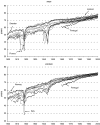Assumptions for long-term stochastic population forecasts in 18 European countries: Hypothèses de projections stochastiquesàlong terme des populations de 18 pays européens
- PMID: 20076758
- PMCID: PMC2798034
- DOI: 10.1007/s10680-006-9104-4
Assumptions for long-term stochastic population forecasts in 18 European countries: Hypothèses de projections stochastiquesàlong terme des populations de 18 pays européens
Abstract
The aim of the 'Uncertain Population of Europe'(UPE) project was to compute long-term stochastic (probabilistic) population forecasts for 18 European countries. We developed a general methodology for constructing predictive distributions for fertility, mortality and migration. The assumptions underlying stochastic population forecasts can be assessed by analysing errors in past forecasts or model-based estimates of forecast errors, or by expert judgement. All three approaches have been used in the project. This article summarizes and discusses the results of the three approaches. It demonstrates how the-sometimes conflicting-results can be synthesized into a consistent set of assumptions about the expected levels and the uncertainty of total fertility rate, life expectancy at birth of men and women, and net migration for 18 European countries.
Le but du projet ‘Uncertain population of Europe’(UPE) était de calculer des projections de population stochastiques (probabilistes)àlong terme des populations de 18 pays européens. Nous avons développé une méthodologie générale pour construire des distributions prédictives de fécondité, mortalité et migration. Les hypothèses sous-jacentes aux projections stochastiques de populations peuvent être élaborées en analysant les erreurs de projections passées, en effectuant une modélisation pour estimer les erreurs de projection, ou par un jugement d’expert. Les trois approches ont été appliquées dans le projet, et leurs résultats sont résumés et discutés dans cet article. Nous démontrons que les résultats, parfois contradictoires, peuvent être synthétisés pour former un ensemble cohérent d’hypothèses concernant les niveaux attendus et l’incertitude autour de l’indice synthétique de fécondité, de l’espérance de vieàla naissance des hommes et des femmes, et de la migration nette dans 18 pays européens.
Figures











References
-
- None
- Alders, M., & de Beer, J. (2004). Assumptions on fertility in stochastic population forecasts. International Statistical Review, 72, 65-9.
-
- {'text': '', 'ref_index': 1, 'ids': [{'type': 'PubMed', 'value': '12292503', 'is_inner': True, 'url': 'https://pubmed.ncbi.nlm.nih.gov/12292503/'}]}
- Alho, J. M. (1997). Scenarios, uncertainty, and conditional forecasts of the world population. Journal of the Royal Statistical Society, A 160(Part 1), 71-5. - PubMed
-
- Alho, J. M. (1998). A stochastic forecast of the population of Finland, Reviews 1998/4. Helsinki: Statistics Finland.
-
- Alho, J. (2005). Stochastic forecasting in a multiregional setting. Paper delivered at Second International Institute of Forecasters, workshop on Stochastic Demographic Forecasting, University of Salamanca, Spain, 28-9 July 2005.
-
- None
- Alho, J. M., Alders, M., Cruijsen, H., Keilman, N., Nikander, T., & Pham, D. Q. (2006). New forecast: Population decline postponed in Europe. Statistical Journal of the UNECE, 23(1), 1-0.
LinkOut - more resources
Full Text Sources
Miscellaneous

